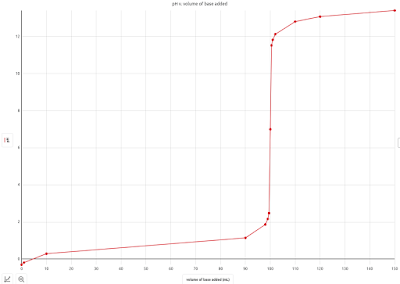When a solid acid or a compound containing hydroxides is dissolved, the pH of the solution is affectedin obvious ways. However, many ionic compounds which are not obviously acidic or basic also affect the pH when they are dissolved.
Understanding why ionic compounds can influence the pH of a solution when they dissolve requires us to think about the ions produced during the solvation of the compound. For instance when sodium acetate is dissolved in water it produces sodium ions and acetate ions:
\(NaC_2H_3O_2 \rightleftharpoons Na^{+1} + C_2H_3O_2^{-1}\)
This, by the way is why we call this hydrolysis. "Hydro" means water, and "lysis" means splitting or breaking. So, water breaks apart ionic compounds - hydro-lysis.
Then what?
Acetate, as a negative ion, is able to "attract" and \(H^{+1}\) from a water molecule creating acetic acid and hydroxide ions (\(OH^{-1}\)):
\(C_2H_3O_2^{-1} + H_2O \rightleftharpoons HC_2H_3O_2 + OH^{-1}\)
The creation of the hydroxide ions, makes the pH of the solution go up.
Of course, you may be wondering about the sodium ions. Since \(Na^{+1}\) doesn't have an \(H^{+1}\) to give to water and the positive charge won't attract any \(H^{+1}\) ions from water, the \(Na^{+1}\) will not have any effect on the pH.
The complication of strong acids
Of course, every negative ion can act as a base (attracting \(H^{+1}\) from water), but not all solutions are basic. The reason has to do with how strong a base the negative ion is. For example, chloride ion (\(Cl^{-1}\)) can act as a base in water according to the reaction here:
\(Cl^{-1} + H_2O \rightleftharpoons HCl + OH^{-1}\)
However, solutions made of chloride are not basic. To understand that we need to think about HCl (the acid on the right side of the reaction above. We know that HCl is a strong acid. As such, reactions involving HCl run (nearly) to completion. That means that in the reaction above, the backward reaction occurs ~100%. Stated differently, the forward reaction happens ~0%. In fact a better way to write that reaction might be:
\(Cl^{-1} + H_2O \leftarrow HCl + OH^{-1}\)
So, because the conjugate of chloride is a strong acid, \(Cl^{-1}\) is a horrible base and can be ignored. This is the reason that a solution of table salt (sodium chloride, NaCl) is neutral -- the \(Na^{+1}\) is not an acid or a base and the \(Cl^{-1}\) is such a bad base that it has no measurable effect.
One more example
Let's ponder what happens when ammonium nitrate (\(NH_4NO_3\))is dissolved in water. The compound breaks up into ions as it dissolves.
\(NH_4NO_3 \rightleftharpoons NH_4^{+1} + NO_3^{-1}\)
The nitrate ion (\(NO_3^{-1}\)) is the conjugate of the strong acid \(HNO_3\) and, as such, has no effect on the pH of the solution.
The ammonium ion (\(NH_4^{+1}\)), however, is the conjugate of the base ammonia (\(NH_3\)). It can react with water:
\(NH_4^{+1} + H_2O \rightleftharpoons NH_3 + H_3O^{+1}\)
Since the reaction makes hydronium ions, the pH will go down and the solution will be acidic.
OK, but what about...
Using the logic above, you should be able to determine whether an ionic compound will make a acidic, neutral or basic solution when dissolved. But, there is one situation where the situation gets complicated: when the solid is composed of a positive ion that is a weak acid and the negative ion is a weak base.
An example of this type of compound might be ammonium nitrite (\(NH_4NO_2\)). The positive ion (\(NH_4^{+1}\)) is a weak acid, and the negative ion (\(NO_2^{-1}|)) is a weak base. That means that both of the following reactions will occur:
\(NH_4NO_3 \rightleftharpoons NH_4^{+1} + NO_3^{-1}\)
and
\(NO_2^{-1} + H_2O \rightleftharpoons HNO_2 + OH^{-1}\)
So, we are creating both hydronium (\(H_3O^{+1}\)) and hydroxide (\(OH^{-1}\)). So the pH is pushed down and up. It would be nice if the answer were just "It's Neutral!" but life isn't that kind. In a situation like this, the answer lies in the relative strengths of the \(K_a\) and \(K_b\). Whichever is larger, "wins" and will determine whether the pH of the solution is below or above 7.


























